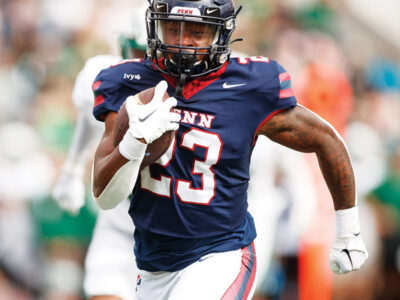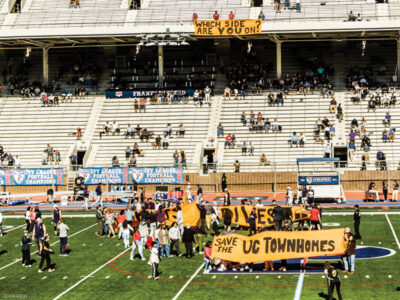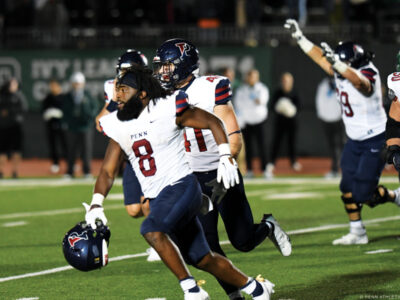By David Porter
The controlled fury that occurs between the white lines on a football field can have devastating physical consequences, yet these pale in comparison to the random jolts meted out by everyday life without regard to whistles, timeouts, or do-overs. Ric San Doval qualifies as an expert in both areas, and his return to football this fall surely qualifies as Penn athletics’ feel-good story of 2005.
Fully recovered from a catastrophic knee injury that nearly cost him his lower leg, the senior linebacker leads a Penn team that came within one game of winning its third consecutive Ivy League championship last fall. That fact is a little deceiving, however, since the one game was a 31-10 loss to Harvard at Franklin Field in which the Quakers were thoroughly outplayed from the opening whistle. Nevertheless, with a loaded offensive backfield returning and San Doval anchoring head coach Al Bagnoli’s customarily stingy defense, another title run is certainly not out of the question. (In the annual Ivy League media poll, Penn edged out Harvard by a point—120 to 119—as the preseason favorite.)
For the two-time All-Ivy selection, the team’s opener on September 17 against Duquesne at Franklin Field will mark the culmination of a year-and-a-half-long rehabilitation process that began following a February 2004 skiing accident.
“It was my first run of the day,” San Doval recalled recently. “They were making snow, and I wanted to stop to clean my goggles. But I lost my edge and slid right into some trees.”
Then came the really bad news: He had hit the trifecta of knee injuries: tears of his anterior cruciate ligament, medial collateral ligament, and meniscus (knee cartilage). Ironically, the patellar collateral ligament he’d torn as a sophomore on the Franklin Field artificial turf remained intact; if it had torn as well, there was a chance he’d have had to have part of his leg amputated.
Against all odds, San Doval hoped to play by midway through last season, and he worked out diligently to that end, but found he was still unable to jump off the leg. By the time he regained his jumping ability, he’d already petitioned for a medical exemption to play another year, so he sat out the rest of the season. At spring practice, he played “like a man possessed,” Bagnoli recalled.
“I told [running-backs coach] Steve Downs, ‘I feel sorry for the guy I’m going to hit first,’“ San Doval said. “I think I ended up bending him over backwards.”
San Doval—who had 86 tackles and 4 1/2 sacks as a junior—leads a strong linebacking crew featuring North Carolina transfer Kory Gedin, a junior, and senior Chad Slapnicka. Behind them, senior defensive backs Casey Edgar and Michael Johns were both honorable mention All-Ivy last season and were part of a defense that allowed 14.5 points per game, fourth-best in Division 1-AA.
On offense, Bagnoli has the happy dilemma of having two quarterbacks with game experience to choose from. Senior Pat McDermott was the starter last season, but an injury in the final seconds of a 16-15 win at Princeton sidelined him for the Harvard game. Sophomore Bryan Walker played gallantly in his place and led the Quakers to a win at Cornell the following week. Walker’s presence should make it easier for Bagnoli to call on the fleet McDermott to use his running skills more often this season.
“Patrick’s a very good runner, but we were always hesitant to put him in harm’s way because we didn’t have an experienced guy to back him up,” Bagnoli said. “Now, we’re looking at a quarterback draw play on third-and-seven as a pretty good alternative.”
The rest of the backfield is deep and talented. Senior running back Sam Matthews ran for nearly 100 yards a game last season behind an inexperienced offensive line, and could challenge Kris Ryan C’02’s career rushing record of 3,181 yards if he bumps up that average by about 20 yards per game. He’ll have the benefit of running behind a line that has four returning players, led by junior tight-end Chris Mizell and senior lineman Don Snyder, both of whom were named All-Ivy. Senior Kyle Ambrogi and juniors Von Bryant, a transfer from Duke, and Joe Sandberg, who transferred from Penn to Rutgers and then back to Penn, give Bagnoli a wealth of weapons to deploy: Bryant has a track athlete’s speed, Ambrogi is a between-the-tackles slasher, and Sandberg combines a little of both.
The biggest hole to fill will be at wide receiver, where Dan Castles W’05 finished his career last season as Penn’s all-time leader in touchdown receptions (27) and with the second-highest total receiving yards (2,444) and the third-most receptions (167). Junior wide receiver Matt Carre, who caught 21 passes last season, is a likely candidate to become McDermott’s go-to receiver among the wideouts, but Bagnoli said he is likely to spread the ball around more this season.
“It’s probably not fair to assume anybody in our program is going to singularly replace such a gifted kid who had such a stellar career,” Bagnoli said about Castles. “My hope is that between the tight end, the running backs, and the wide receivers coming back, that we can make up those catches.”
What Bagnoli will also have to contend with is the fact that, based on last year’s results, the rest of the Ivy League teams may be making up ground on his team, despite the fact that only Harvard has been able to defeat Penn since the 2000 season. Six of the Quakers’ victories in 2004 were by less than two touchdowns, and wins over Princeton, Brown, and Cornell were by a total of 11 points. No one is better suited to the task than Bagnoli, whose teams have not lost back-to-back games since the middle of the 1999 season.
“We’ve been fortunate to have kids who have resiliency and some pride in what they’re trying to do,” he said. “It’s more of a reflection on their commitment and their poise [than] anything else.”
David Porter C’82 writes for the Associated Press.




